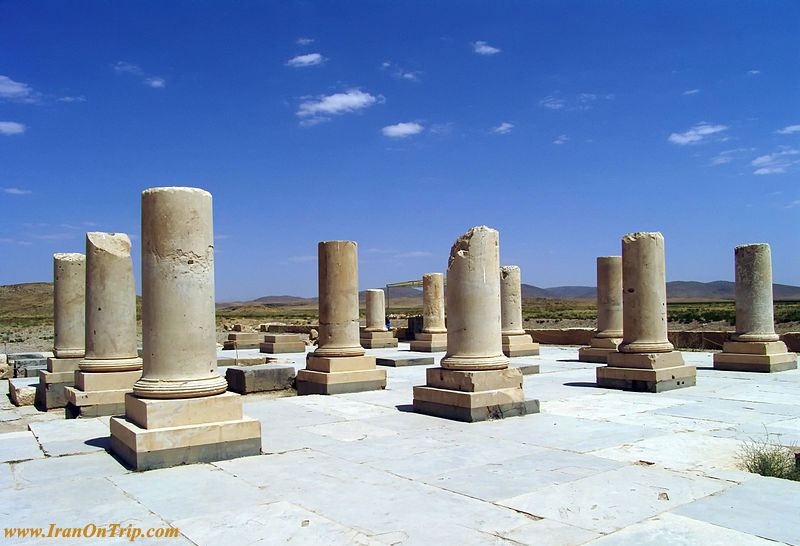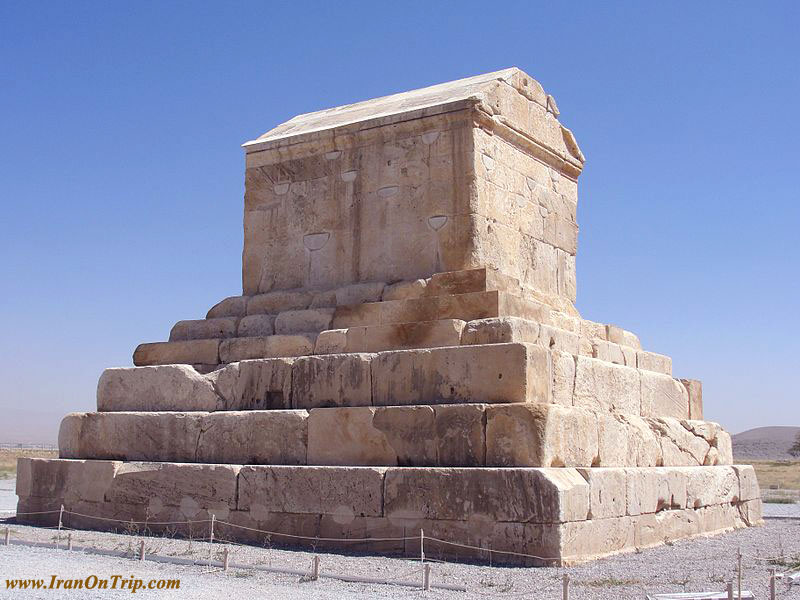Pasargadae Palaces

Pasargadae (Persian: Pasargad, from Ancient Greek: Πασαργaoαι), the capital of Cyrus the Great (559–530 BC) and also his last resting place, was a city in ancient Persia (modern-day Iran), located near the city of Shiraz (in Pasargad County) and is today an archaeological site and one of Iran's UNESCO World Heritage Sites.
History
Cyrus the Great began building his capital in 546 BCE or later; it was unfinished when he died in battle, in 530 or 529 BCE. The remains of the tomb of Cyrus' son and successor, Cambyses II, has been found in Pasargadae, near the fortress of Toll-e Takht, and identified in 2006.
Pasargadae remained the Persian capital until Cambyses II moved it to Susa; later, Darius founded another in Persepolis. The archaeological site covers 1.6 square kilometres and includes a structure commonly believed to be the mausoleum of Cyrus, the fortress of Toll-e Takht sitting on top of a nearby hill, and the remains of two royal palaces and gardens. Pasargadae Persian Garden provide the earliest known example of the Persian chahar bagh, or fourfold garden design (see Persian Gardens).
Recent research on Pasargadae’s structural engineering has shown that Achaemenid engineers built the city to withstand a severe earthquake, what would today be classified as 7.0 on the Richter magnitude scale.
The tomb of Cyrus the Great

The most important monument in Pasargadae is the tomb of Cyrus the Great. It has six broad steps leading to the sepulchre, the chamber of which measures 3.17 m long by 2.11 m wide by 2.11 m high and has a low and narrow entrance. Though there is no firm evidence identifying the tomb as that of Cyrus, Greek historians tell that Alexander III of Macedon believed it was. When Alexander looted and destroyed Persepolis, he paid a visit to the tomb of Cyrus. Arrian, writing in the second century of the common era, recorded that Alexander commanded Aristobulus, one of his warriors, to enter the monument. Inside he found a golden bed, a table set with drinking vessels, a gold coffin, some ornaments studded with precious stones and an inscription on the tomb. No trace of any such inscription survives, and there is considerable disagreement to the exact wording of the text. Strabo reports that it read:
Passer-by, I am Cyrus, who gave the Persians an empire, and was king of Asia.
Grudge me not therefore this monument.
Another variation, as documented in Persia: The Immortal Kingdom, is:
O man, whoever thou art, from wheresoever thou cometh, for I know you shall come, I am Cyrus, who founded the empire of the Persians.
Grudge me not, therefore, this little earth that covers my body
The design of Cyrus' tomb is credited to Mesopotamian or Elamite ziggurats, but the cella is usually attributed to Urartu tombs of an earlier period. In particular, the tomb at Pasargadae has almost exactly the same dimensions as the tomb of Alyattes II, father of the Lydian King Croesus; however, some have refused the claim (according to Herodotus, Croesus was spared by Cyrus during the conquest of Lydia, and became a member of Cyrus' court). The main decoration on the tomb is a rosette design over the door within the gable. In general, the art and architecture found at Pasargadae exemplified the Persian synthesis of various traditions, drawing on precedents from Elam, Babylon, Assyria, and ancient Egypt, with the addition of some Anatolian influences.
During the Islamic conquest of Iran, the Arab armies came upon the tomb and planned to destroy it, considering it to be in violation of the tenets of Islam. The caretakers of the grave managed to convince the Arab command that the tomb was not built to honor Cyrus but instead housed the mother of King Solomon, thus sparing it from destruction. As a result, the inscription in the tomb was replaced by a verse of the Qur'an, and the tomb became known as the "tomb of the mother of Solomon". It is still widely known by that name today.
Archaeology

The first capital of the Achaemenid Empire, Pasargadae lies in ruins 43 kilometers from Persepolis, in present-day Fars province of Iran.Pasargadae was first archaeologically explored by the German archaeologist Ernst Herzfeld in 1905, and in one excavation season in 1928, together with his assistant Friedrich Krefter (de). Since 1946, the original documents, notebooks, photographies, fragments of wall paintings and pottery from the early excavations are preserved in the Freer Gallery of Art, Smithsonian Institution, in Washington, DC. After Herzfeld, Sir Aurel Stein completed a site plan for Pasargadae in 1934. In 1935, Erich F. Schmidt produced a series of aerial photographs of the entire complex.
From 1949 to 1955, an Iranian team led by Ali Sami worked there. A British Institute of Persian Studies team led by David Stronach resumed excavation from 1961 to 1963. After a gap, work was resumed by the Iranian Cultural Heritage Organization and the Maison de l'Orient et de la Méditerranée of the University of Lyon in 2000.
In culture
In 1930, the Brazilian poet Manuel Bandeira published a poem called "Vou-me embora pra Pasargada" ("I will go away to Pasargadae" in Portuguese), in a book entitled Libertinagem. It tells the story of a man who wants to go to Pasargadae, described in the poem as a utopian city. This poem has become one of the Portuguese language´s classics.
.....
.....
.....

.jpg)



























